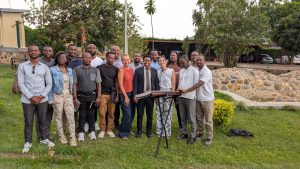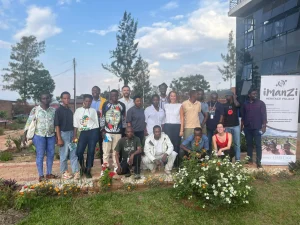From Nyamasheke to Kigali: Empowering Communities Through Cultural Heritage in Rwanda
By Eirini Oikonomidi, Rwanda Projects Manager
During the recent, nearly month-long visit to Rwanda, two successful and highly engaged workshops were conducted under the theme: “Engaging Communities in Cultural Heritage.” The training gathered 37 heritage practitioners who offered valuable insights, exchanged knowledge, and shared on-the-ground experience.
The workshops were led by Lena Stefanou and Aris Anagnostopoulos, whose expertise guided participants through practical strategies for community involvement.
The first workshop took place in the southwestern region of Rwanda, in Nyamasheke. This location was strategically chosen because the area is considerably more remote from Kigali, marking a significant step in expanding our programme’s on-site presence. Partnering with IVOMO, who provided crucial organisation and coordination support, the workshop focused intensely on local needs and specific challenges faced by communities in the Great Lakes region. The week spent in this tropical landscape underscored the importance of reaching remote areas to ensure a broad national impact.
Following the Nyamasheke session, the second workshop was hosted in Kigali, the capital of the country. This session broadened the discussion to encompass a wider range of stakeholders, organisations, and dynamic national applications. Our essential partner, the Rwanda Cultural Heritage Academy (RCHA), as always, provided excellent logistical support, including the necessary room and materials at the Kandt House Museum.
Ultimately, both intensive workshops provided fertile ground for the exchange of knowledge, the development of strategies, and the reinforcement of the role of local communities in the protection, preservation, and utilisation of cultural heritage as a driver for sustainable development.
Field Visits and Strategic Engagement
Following the successful completion of the workshops, the remaining weeks of the mission were dedicated to crucial field visits and high-level stakeholder meetings across Rwanda. As the Country Manager, I embarked on an extensive schedule to personally visit projects on the ground, covering a significant geographical expanse—from the tranquil shores of Lake Kivu in the west, across to the Ngoma District in the east, and down into the Southern Province.
This commitment to comprehensive on-the-ground presence yielded two vital outcomes for both our organisation and our local partners.
First, for me, the visits provided a vastly improved and granular understanding of the actual situation. Observing the projects firsthand allowed me to gain immediate clarity on their evolution, their current state, the specific difficulties local teams face, and their overall trajectory. This practical insight is indispensable for effective strategic planning.
Second, the impact on our local partners and the communities themselves was equally profound. By prioritising this on-site presence, we achieved a deeper connection that served to empower the local teams significantly. Our physical presence demonstrated a genuine interest and commitment, signaling the high value we place on their efforts and achievements. We had the opportunity to meet the dedicated individuals face-to-face, fostering stronger personal and professional relationships that reinforce the communities’ sense of ownership and dedication to the long-term sustainability of their cultural heritage work.
In short, these field visits transformed our theoretical understanding into tangible knowledge, strengthening both our project oversight and the foundational local partnerships necessary for lasting impact in Rwanda.


